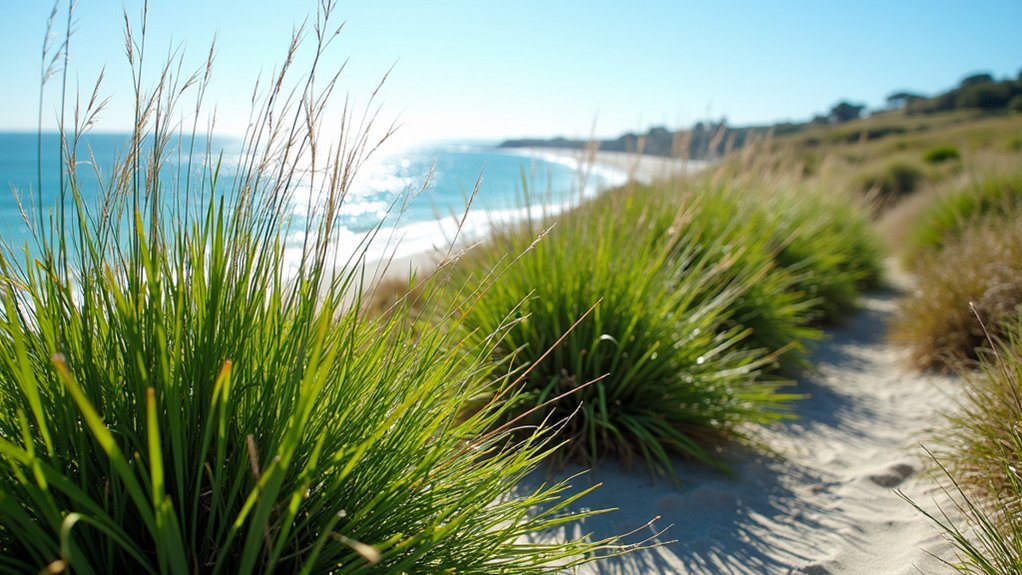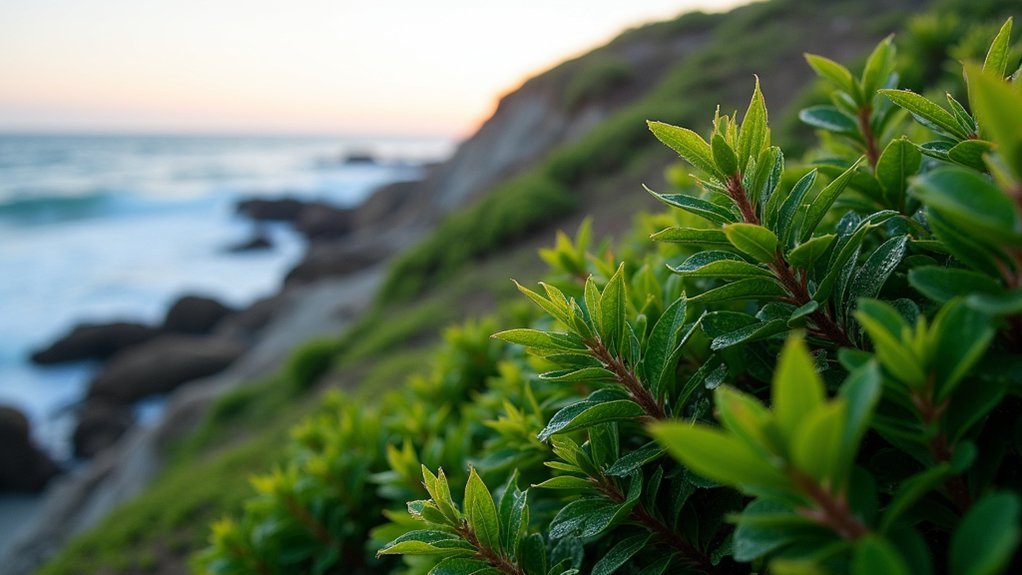For coastal homes, you’ll find excellent living fence options in Northern Bayberry, American Beach Grass, and Miscanthus grass. These hardy plants withstand salt spray, stabilize soil, and create effective wind barriers while requiring minimal maintenance. Northern Bayberry even improves soil quality with its nitrogen-fixing abilities. All three options offer both functional protection and visual appeal, transforming your coastal property while standing strong against maritime challenges.
Salt-Tolerant Shrubs That Thrive in Coastal Conditions

Five exceptional salt-tolerant shrubs can transform your coastal property into a thriving, protected haven.
Beach Strawberry offers dual benefits as ground cover and fruit producer while standing strong against persistent salt spray.
Beach Strawberry delivers delicious edible fruit while serving as resilient ground cover that laughs in the face of coastal salt spray.
Sea Lavender adds visual appeal with its purple blooms that attract pollinators to your coastal landscape.
For effective hardy living fences, consider American Beach Grass, which excels at stabilizing dunes while withstanding harsh coastal conditions.
Bayberry provides robust protection with drought resistance and produces aromatic berries that attract birds, enhancing biodiversity around your home.
Don’t overlook Northern Bayberry, which not only tolerates challenging shoreline environments but also improves your soil through its natural nitrogen-fixing abilities.
These salt-tolerant shrubs create natural boundaries that protect your property while beautifying your coastal garden, all while thriving where other plants surrender.
Wind-Resistant Grasses and Succulents for Natural Barriers
Creating effective windbreaks begins with selecting grasses and succulents that won’t surrender to coastal gales. Consider Miscanthus and Panicum, wind-resistant grasses that grow tall and dense, forming natural barriers while enhancing your garden’s aesthetic appeal.
For hardy living fences with minimal upkeep, incorporate drought-tolerant succulents like Agave and Aloe. Their thick, fleshy leaves withstand harsh coastal conditions beautifully.
You’ll appreciate how native coastal plants such as Beach Strawberry and Sea Oats contribute to soil stabilization and prevent erosion while protecting your property.
For maximum effectiveness around coastal homes, try layering both grasses and succulents to create adaptable barriers that respond to varying wind patterns. This combination not only provides functional protection but offers striking visual interest year-round—all while requiring less water and maintenance than traditional fencing options.
Maintenance Strategies for Living Coastal Fences

While living fences provide natural protection for coastal homes, they require consistent care to maintain their effectiveness against harsh maritime conditions. Your maintenance strategies should focus on preventing salt damage and guaranteeing proper moisture retention at your coastal home.
Living fences offer coastal protection but demand regular maintenance to combat salt exposure and ensure moisture balance.
- Regularly inspect your living fences for leaf burn or discoloration, trimming affected areas promptly to encourage healthy regrowth and resilience.
- Apply organic mulch around the base to suppress weeds, improve soil quality, and help retain essential moisture during dry periods.
- Implement annual pruning to maintain shape while fertilizing with slow-release products specifically formulated for coastal plants.
During drought, don’t forget to water your living fence, especially for sensitive species.
These maintenance practices will guarantee your natural barrier remains strong and beautiful while continuing to protect your coastal property year-round.
Frequently Asked Questions
What Is the Best Fencing for Coastal Areas?
You’ll want aluminum fencing for coastal areas as it resists salt air corrosion. Treated wood offers natural beauty, while glass panels provide unobstructed views. Choose slatted designs that allow wind passage during storms.
What Is the Best Fence for Waterfront Property?
For your waterfront property, you’ll want aluminum, treated wood, or glass panel fencing. They’re durable against salt exposure and high winds. Choose rustproof fixtures and consider slatted designs to maintain views while providing protection.
What Type of Fence Has the Least Maintenance?
Vinyl fencing has the least maintenance of all fence types. You’ll only need to rinse it occasionally with a garden hose to remove dirt. Aluminum is another low-maintenance option that won’t require painting or staining.
How Much Does a Living Fence Cost?
Living fences typically cost $15-$50 per linear foot. You’ll also need to budget for installation labor ($30-$70/hour), plus annual maintenance of $100-$300. Don’t forget soil amendments and pest protection costs of $200-$500.
In Summary
When you’re building coastal living fences, you’ll find these salt-tolerant shrubs, wind-resistant grasses, and sturdy succulents offer both protection and beauty for your seaside property. Don’t forget to follow the maintenance strategies we’ve outlined—regular pruning, occasional soil amendments, and seasonal inspections will keep your living barrier thriving year after year. With these hardy options, you’re well-equipped to create a natural fence that stands up to coastal challenges.




Leave a Reply